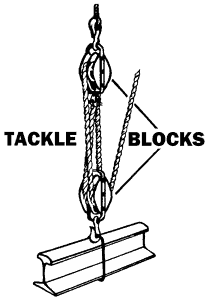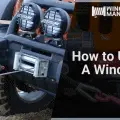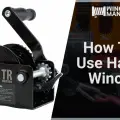
Including a winch into your vehicle is likely the best attachment you can add to your vehicle. Regardless of the way that your vehicle is designed for the harshest of landscapes, they can’t handle them all. At the end of your trip, you may face a couple of challenges and landscapes that cause your vehicle to get stuck From mud, snow, and steep rocks, a winch can most likely be useful when stuck in those conditions. Not only a winch can help you when stuck, but it can also help you in utility work.
A winch can without a doubt help you in unforgiving conditions, yet once in a while, the winch alone is lacking at it. There could be conditions where you are struggling to find a mooring point for your winch. Another issue could be your winch comes up short on the pulling power expected to get yourself out. That is the reason winches come with tool packs in them, particularly those winches that are utilized for self recuperation when stuck. The tools in those packs can be utilized to help the winch when it ends up in complicated situations. One of these tools in the pack is a block and tackle.
A block and tackle are not only limited to self-recovery when stuck, they can be incredibly useful when it comes to utility. Your winch cables can use them by wrapping the winch cable around it. The winch cable is threaded through the pulleys to provide a mechanical advantage that amplifies the force applied to the cable.
At a Glance
What Is A Block And Tackle?
A block is a set of pulleys or sheaves fixed on a single frame. An arrangement of blocks with a rope threaded through the pulleys is called tackle. It is portrayed by the utilization of a single consistent rope to transfer tension around at least one pulleys to hoist a load. Its mechanical favorable position is the number of parts of the rope that hoists the load. The mechanical favorable position of a tackle directs how much simpler it is to take or hoist a load.
A block and tackle are incredibly useful, as stated previously they can increase your winch’s weight capacity. They can be used to assist the winch with whatever tasks that the winch might not be able to handle. The pulley is designed to sustain heavy loads and can be used to redirect cables also for when self recovery when stuck. If you have problems because your winch does not have the necessary pulling power a block and tackle can be useful.
How To Use A Block And Tackle?
In this tutorial, we are going to teach you how to use the block and tackle for self recovery and utility.
Safety: Before we get involved in any activity make sure to always keep safety in mind. Winches are designed to pull thousands of force, so be especially careful when handling it. For more safety information, refer to this guide.
Self Recovery
- Find A Stable Anchoring Point: Find a stable anchoring point that can withstand the weight of winching your car out.
- Wrap A Tree Trunk Protector Around The Anchoring Point: A tree trunk protector is a nylon strap with a loop at each end. Wrap the straps around the stable anchoring point and position the loops around that they are facing you.
- Attach A D-Shackle: Attach a D-shackle to the two ends of the straps.
- Pull Out The Winch Cable: Pull out the winch cable from the winch, but don’t pull too much that it causes unnecessary slack. This is done by turning the lever, selecting the “free spool” or “disengage” option.
- Thread The Winch Cable Around Block And Tackle: Thread your winch cable into the block and tackle and wrap it around the block.
- Hook The Block And Tackle To The D-Shackle: Next simply attach your winch pulley block to the D-shackle that is attached to the tree trunk protector.
- Attach The Winch Cable Back To You Car’s Recovery Hook: Locate your car’s recovery hooks or points then attach the winch cable hook there. If there are none, just find a stable place in your car’s frame where you can hook your winch cable.
- Turn The Lever to Engage: Your winch should also have a label “Engage”. Turn the lever to the label “Engage”, this prevents from anymore winch cable from coming out.
- Gently Press The Gas: Drive the vehicle towards the anchoring point slowly while winching at the same time.
- Stop Winching: Once you find yourself in a stable position and now able to drive, stop winching.
Utility
- Spool The Winch: Allow the winch spool freely so that you can you’ll out the winch strap freely.
- Pull Out The Winch Cable: Pull out the winch cable from the winch, but don’t pull too much that it causes unnecessary slack. This is done by turning the lever, selecting the “free spool” or “disengage” option.
- Thread The Winch Cable Around Block And Tackle: Thread your winch cable into the block and tackle and wrap it around the block.
- Wrap A Winch Strap Around The Load: Wrap a winch strap around the load. Make sure the winch strap is not twisting, if so, straighten it.
- Attach A D-shackle: Now that you have wrapped a winch strap, attach a D-shackle on it.
- Hook The Block And Tackle To The D-Shackle: Next simply attach your winch pulley block to the D-shackle that is attached to the load.
- Turn The Lever to Engage: Your winch should also have a label “Engage”. Turn the lever to the label “Engage”, this prevents from anymore winch cable from coming out.
- Hoist The Load: Using the remote, simply press the button up or down spending on your desired location.
Winch Recommendations
If you are going to consider buying a winch, consider a 120 volt winch. The 120 volt winch is light and portable and can easily be installed without much hassle. Though it is lightweight and does not offer much pulling power, but with block and tackle it can handle it.
Here are our 120 volt winch recommendations:
- WARN 885000 PullzAll Corded 120V AC Portable Electric Winch
- WARN 85330 1500AC 120V Electric Utility Winch
- Dutton-Lainson Company SA12015AC 120 Volt/2700 lbs/4000 lbs, Electric Winch
- KEEPER KAC1500 110/120V AC Electric Winch
- WARN 80010 1000AC 120V Electric Utility Winch
Conclusion
Getting a block and tackle is a cheap way of increasing your winch’s weight capacity. Do you have plans in getting one? Do you think I missed something? Comment below. We also offer other tips and guides well such as Best Hand Winches Review, Best Portable Winch Review, and How to Attach Cable to Winch Drum.



